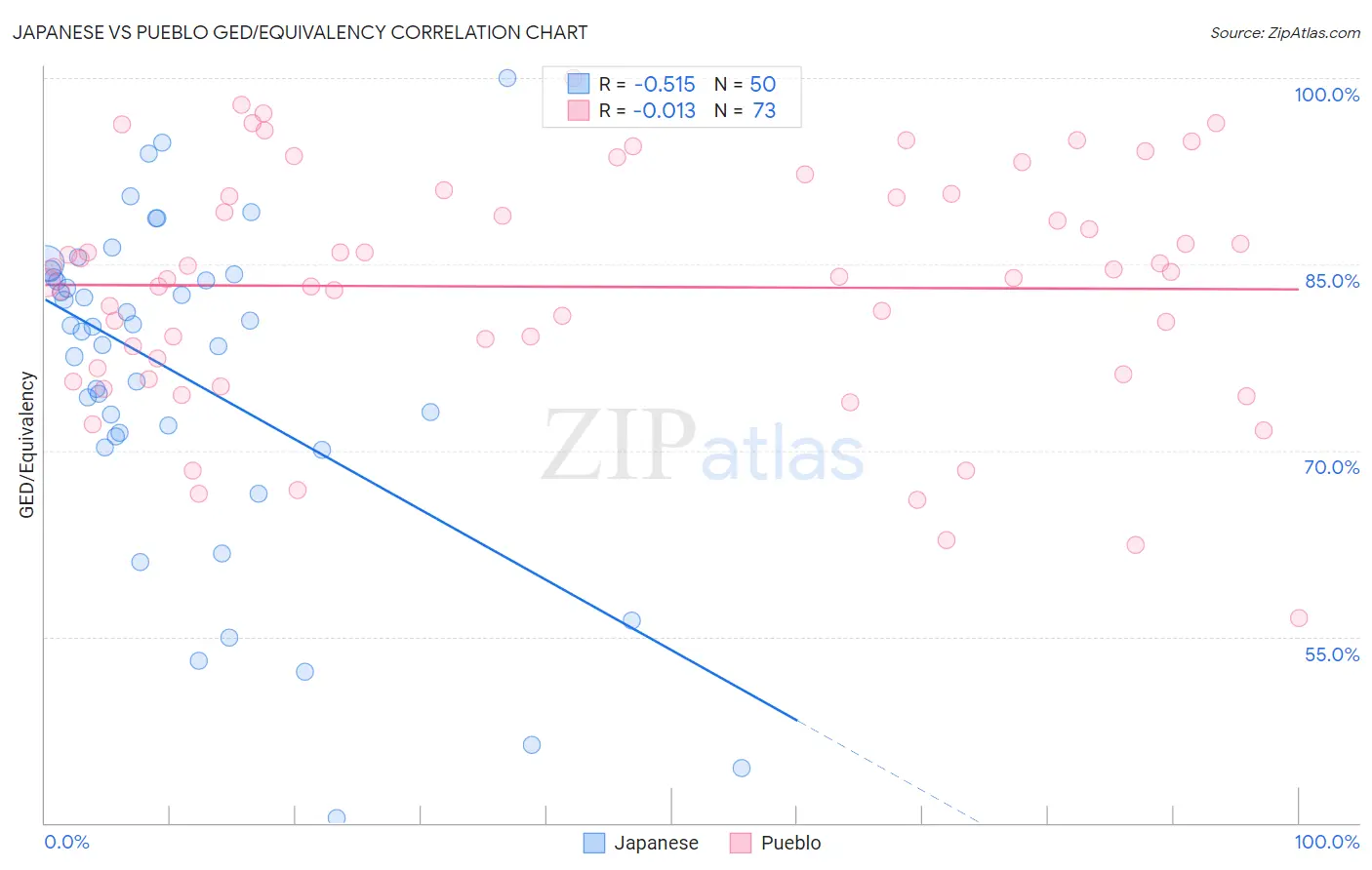Japanese vs Pueblo GED/Equivalency
COMPARE
Japanese
Pueblo
GED/Equivalency
GED/Equivalency Comparison
Japanese
Pueblo
82.4%
GED/EQUIVALENCY
0.0/ 100
METRIC RATING
287th/ 347
METRIC RANK
82.3%
GED/EQUIVALENCY
0.0/ 100
METRIC RATING
288th/ 347
METRIC RANK
Japanese vs Pueblo GED/Equivalency Correlation Chart
The statistical analysis conducted on geographies consisting of 249,183,224 people shows a substantial negative correlation between the proportion of Japanese and percentage of population with at least ged/equivalency education in the United States with a correlation coefficient (R) of -0.515 and weighted average of 82.4%. Similarly, the statistical analysis conducted on geographies consisting of 120,086,468 people shows no correlation between the proportion of Pueblo and percentage of population with at least ged/equivalency education in the United States with a correlation coefficient (R) of -0.013 and weighted average of 82.3%, a difference of 0.10%.

GED/Equivalency Correlation Summary
| Measurement | Japanese | Pueblo |
| Minimum | 40.4% | 56.5% |
| Maximum | 100.0% | 100.0% |
| Range | 59.6% | 43.5% |
| Mean | 75.8% | 83.2% |
| Median | 79.8% | 84.0% |
| Interquartile 25% (IQ1) | 71.1% | 76.4% |
| Interquartile 75% (IQ3) | 83.9% | 90.6% |
| Interquartile Range (IQR) | 12.8% | 14.2% |
| Standard Deviation (Sample) | 13.3% | 9.6% |
| Standard Deviation (Population) | 13.1% | 9.6% |
Demographics Similar to Japanese and Pueblo by GED/Equivalency
In terms of ged/equivalency, the demographic groups most similar to Japanese are Immigrants from West Indies (82.4%, a difference of 0.020%), Cajun (82.4%, a difference of 0.040%), Immigrants from Barbados (82.4%, a difference of 0.070%), Immigrants from Cambodia (82.2%, a difference of 0.18%), and Indonesian (82.5%, a difference of 0.19%). Similarly, the demographic groups most similar to Pueblo are Immigrants from Cambodia (82.2%, a difference of 0.080%), Immigrants from West Indies (82.4%, a difference of 0.12%), Cajun (82.4%, a difference of 0.14%), Immigrants from Barbados (82.4%, a difference of 0.17%), and Haitian (82.1%, a difference of 0.27%).
| Demographics | Rating | Rank | GED/Equivalency |
| Arapaho | 0.1 /100 | #277 | Tragic 82.8% |
| Immigrants | Laos | 0.1 /100 | #278 | Tragic 82.7% |
| Immigrants | Fiji | 0.1 /100 | #279 | Tragic 82.7% |
| Cheyenne | 0.1 /100 | #280 | Tragic 82.7% |
| Sioux | 0.1 /100 | #281 | Tragic 82.6% |
| Immigrants | Immigrants | 0.1 /100 | #282 | Tragic 82.6% |
| Indonesians | 0.1 /100 | #283 | Tragic 82.5% |
| Immigrants | Barbados | 0.1 /100 | #284 | Tragic 82.4% |
| Cajuns | 0.0 /100 | #285 | Tragic 82.4% |
| Immigrants | West Indies | 0.0 /100 | #286 | Tragic 82.4% |
| Japanese | 0.0 /100 | #287 | Tragic 82.4% |
| Pueblo | 0.0 /100 | #288 | Tragic 82.3% |
| Immigrants | Cambodia | 0.0 /100 | #289 | Tragic 82.2% |
| Haitians | 0.0 /100 | #290 | Tragic 82.1% |
| Cubans | 0.0 /100 | #291 | Tragic 82.0% |
| Paiute | 0.0 /100 | #292 | Tragic 82.0% |
| British West Indians | 0.0 /100 | #293 | Tragic 82.0% |
| Immigrants | St. Vincent and the Grenadines | 0.0 /100 | #294 | Tragic 82.0% |
| Nepalese | 0.0 /100 | #295 | Tragic 81.9% |
| Vietnamese | 0.0 /100 | #296 | Tragic 81.9% |
| Immigrants | Bangladesh | 0.0 /100 | #297 | Tragic 81.9% |